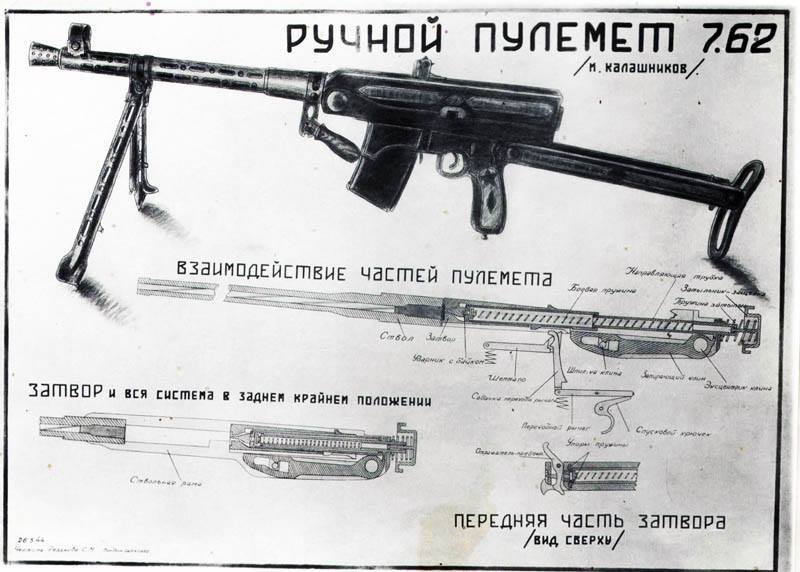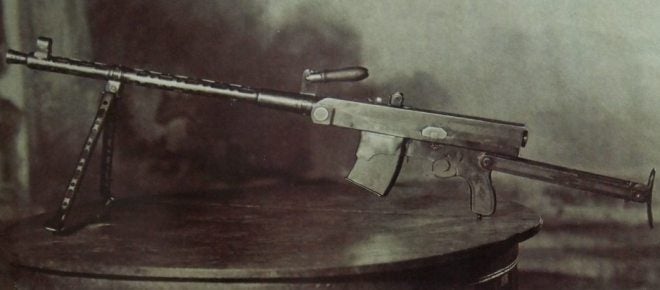Today’s guest post is written by Andrey Ulanov. Andrey is a firearms enthusiast, historian, researcher and writer. He is the author of numerous interesting small arms articles in various websites. Here is an example of an article written by Andrey. Let’s see what’s the story of Mikhail Kalashnikov’s first light machine gun.
Kalashnikov light machine gun (RPK) – an evolution of the original AK rifle – has a distinct association in most people’s minds nowadays. Even though this machine gun doesn’t have positive reviews from all of its operators, it is likely to stay in service and get used in battles for much longer.
However, not many people remember that Mikhail Kalashnikov invented his first light machine gun much earlier. It was that light machine gun that became Kalashnikov’s first major invention in 1943-1944 as a young designer.
The process is described in Kalashnikov’s memoirs:
“After having asked me about the progress of testing in detail, Gluhov Vladimir Vasilyevich was also curious:
- What will you work on next?
- I will keep working on the light machine gun if you don’t have any objections.
- Well, the machine gun it is then. The testing contest for it was announced last year. But bear in mind that the requirements are harsh. Some of the most famous designers are working on it. The competition will be tough.
…
By then, I knew the route from Moscow to the testing facility by heart. That’s why we took off in that direction by ourselves. It was a long way from the train station to the facility itself, which gave us a lot of weary minutes. We got off the train at night. The snowstorm was at its peak. We had to travel a few kilometers on foot. Taking that path оn а clear and sunny weather – is a breeze. But this time it was one big snow whirlwind. Besides, we had a heavy crate full of firearm samples to carry. We took off our belts, tied them around the crate and started dragging it. This was the only option. By the time we got to the testing facility’s checkpoint, we were literally exhausted.
The tests set off the following morning. Three different machine guns were introduced in the contest: V.A. Degtyarev’s, S.G. Simonov’s and mine. They got to the final stage of the contest. I won’t go into all the details of the tests. I just want to say that my prototype didn’t pass the test. The committee concluded that it had no advantages over previously put in production models. That’s how my light machine gun became a museum item.
I have to admit that this failure severely hit my self-esteem. The fact that the prototypes by a more experienced designer – V.A. Degtyarev were not approved either didn’t make it any better, neither did I feel any relief when Siminov’s machine gun got off the track too.”

We get a slightly different picture by examining the Main Artillery Department’s documents, however.
First of all, the main parts of the contest took place in 1943. The Siminov’s (RPS) magazine-fed and Degtyarev’s (KBP-180) belt-fed prototypes were in the leading positions by then. Kalashnikov’s name in relation to light machine guns was not mentioned at that time. It is also obvious from the dates: the final stages of the tests took place in the fall of 1943 when Kalashnikov had only just started working on his light machine gun. The final choice was made after the “Vystrel” courses at the end of October 1943. As a result, the Committee of the Main Artillery Department recommended producing 300 pieces of Simonov’s machine guns for further military tests.
Speaking of Kalashnikov’s light machine gun, its tests most likely did set off on the morning of August 23rd, 1944.
Meanwhile, right in the beginning of the report, it was stated that: “7.62mm Kalashnikov’s light machine gun can only be regarded as a working sample of the machine gun in terms of quality of parts manufacture and cycling, thus is now eligible for full-scale fire tests.”
The main “zest” was the design of the cycling parts. Kalashnikov implemented barrel short recoil and…. bolt recoil scheme in his prototype. This reduced weight and simplified the design. But, unfortunately, the original and new design didn’t necessarily mean reliability. Fire tests of Kalashnikov light machine gun ended after 29 shots – until the extractor broke. All in all the design was not given credit for further development recommendations.
Nevertheless, it was even in this “raw” prototype that the testing facility personnel and main Artillery Department’s officers pointed out a series of unique and original solutions, and this was mentioned in the final report.
“In general the light machine gun design is not original and is not worth any special attention, but some of the parts and mechanisms have some new and original approach in them and can be recommended for use in new firearms design procedures.”
Obviously, this kind of recommendation for “certain parts and mechanisms” didn’t sound too prestigious for the future designer of the AK and the PK. On the other hand, it was a major achievement for the designer, who had only managed to produce 2 prototypes of firearms by then. Many of the other famous designers’ prototypes were not awarded such recommendations.
 Your Privacy Choices
Your Privacy Choices
